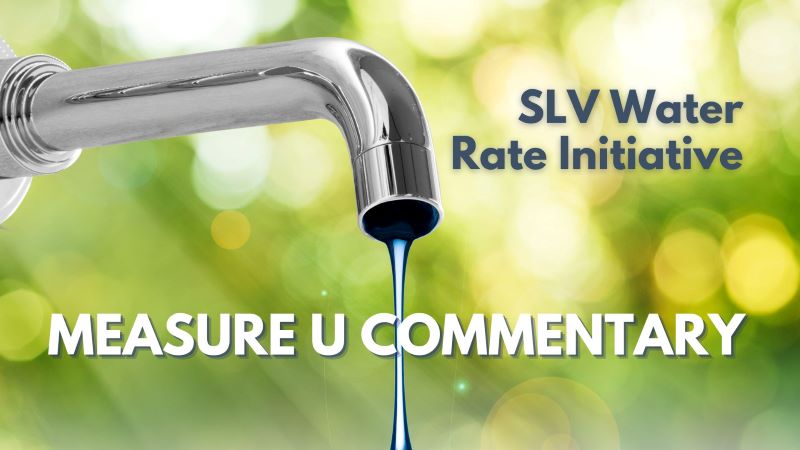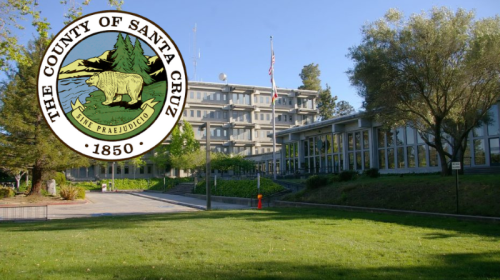The Story Behind Measure U: Even a Water District Must Pay Its Bills
By Lee Summers
Running a water district is a lot like managing a household—they both need a funding source like a job or a fee structure; they both have bills to pay like maintenance, PG&E, and transportation; and both have to balance income with expenses. If the paycheck fails to keep up with raising costs, something has to change.
Life in SLV is both beautiful and rustic. For a water district, the steep terrain and miles of waterlines create maintenance headaches. In 2014, the SLV Water District (SLVWD) began a leak detection program searching 151 miles of waterlines for breaks. A total of fifty-six out of fifty-nine ruptures were repaired, saving over 110 gallons of water per minute. But those fixes were just the tip of the iceberg.
As bad luck would have it, drought hit. From 2012 to 2016 Governor Jerry Brown declared a drought state of emergency. Californians dutifully conserved water and their bills went down––good for customers, not for water districts. Conservation for a water district is like taking a pay cut.
This was not unique to SLV. Throughout the state, water rates increased seven percent from 2007 to 2014 and SLVWD joined that trend. In 2007 the District increased their rates ten percent. Starting in 2016, and thanks to a drought surcharge, a series of capital improvement projects lined up, including major pipeline and storage tank upgrades.
Meanwhile, SLVWD grew in size and customers. First it purchased the Felton Water District in 2006 and then merged with the Lompico Water District in 2016. With the additional 2000 ratepayers, its staff also grew from around twenty-five to thirty-five along with salaries and benefits.
That growth necessitated more rate increases. The District proposed and received ten to eleven percent increases from 2014 to 2016. From 2017 to 2022 its rates grew again from five to thirty-seven percent. And somewhere in there, the fire hit.
The 2020 CZU fire destroyed storage tanks and over seven miles of raw water supply lines. It impacted water treatment systems, pumps, water quality monitoring systems, and water transmission pipelines all to the tune of over $20 million. Although FEMA would pay for as much as ninety percent of the work, they would only reimburse the District upon completion—payments often taking three to five years. Bridge loans became necessary.
In 2021, the District passed a fire surcharge, adding $9.67 to customer’s bills for a period of five years. This added fee would fund the District’s out-of-pocket expense, which FEMA or state grants would not pay.
As if that wasn’t enough, SLV rang in the New Year of 2023 with a storm that cost $1.3 million in damages needing another FEMA grant… and bridge loan… and funding source for out-of-pocket expenses. Hence, the 2023 rate increases.
This new rate structure would not only allow the District to repair fire and storm damage but also replace under-sized and leaking mains, increase water storage, and improve system-wide reliability for emergencies like another fire.
For district customers, that meant two significant changes to your bills. Fixed rates grew from thirty-seven to forty-five percent. In other words, the District added an eight percent increase just for the ability to turn on a faucet, regardless of how much customers used. Go on vacation or a business trip for a month (where back home not a drop of water flowed) and you’d still return to a fixed-rate bill.
And yet, if another fire erupted, fire crews would also have a ready faucet to extinguish the flames.
In order to compensate for that hefty fixed-rate increase, the District added a tiered structure to the volumetric rate. Where before, everyone paid a flat $12.66 per unit of water, now the rate depended on how much water customers used—consume more, pay more for each sequential tier.
This way, ratepayers could lower their bill by using less water, and the District would have the means to pay for essential upgrades, the collateral to receive bridge loans, and funding for out-of-pocket fire-and-storm repairs… even during droughts when everyone conserved.
The District’s income and expenses could finally balance, something every household could appreciate.
Except there was a catch: proposition 218 allowed opponents to reject such increases, first by motivating more than half the customers to file a formal complaint—a campaign that failed—and second by collecting opposing signatures of at least five percent of the ratepayers—a campaign that succeeded.
Thus Measure U was born.
This November 5, SLVWD customers will vote on the 2023 rate increases. A yes vote will repeal the fixed water charges and limit any further increases to two percent per calendar year until January 1, 2049. It will also cost the District election and legal fees, staff time to reapply for bridge loans, interruption of work on infrastructure projects, and questionable funding for any future emergencies.
On the plus side, it will save the average customer $17.32 per month; that is, until another rate increase passes—an expensive process that can take up to eighteen months.
A no vote will maintain the fee increases and give the tools SLVWD needs to bring its infrastructure into the twenty-first century.
It’s easy to take our water for granted. Recent studies have shown that over four billion people around the world do not have access to clean drinking water. We do, and it’s great water!
Our infrastructure is another story.
Lee Summers is a Boulder Creek resident and community volunteer.
***
Have a letter or commentary to share? The San Lorenzo Valley Post welcomes your Santa Cruz Mountains news, story ideas, photos, and letters. Send us an email.
Sign up for our newsletter to stay connected to news and events in the Santa Cruz Mountains.
The San Lorenzo Valley Post is your essential guide to life in the Santa Cruz Mountains. We're dedicated to delivering the latest news, events, and stories that matter to our community. From local government to schools, from environmental issues to the arts, we're committed to providing comprehensive and unbiased coverage. We believe in the power of community journalism and strive to be a platform for diverse voices.





